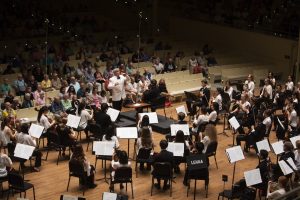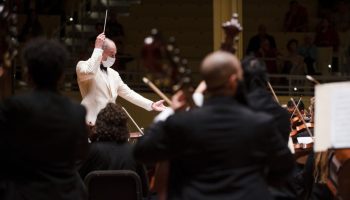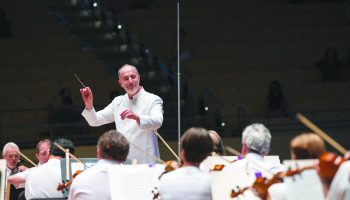
Tonight, the Chautauqua Symphony Orchestra and the Music School Festival Orchestra will perform a piece that changed the course of musical history and even started a riot.
The concert, at 8:15 p.m. tonight, July 18, in the Amphitheater, features Igor Stravinsky’s “The Rite of Spring.” Alongside Stravinsky’s piece, the orchestras will play Alfred Schnittke’s “(K)ein Sommernachtstraum.”
CSO Conductor and Music Director Rossen Milanov said “The Rite of Spring” “literally changed the way we hear music, the way music is composed.”
The piece’s influence began with a controversial premiere in 1913. Stravinsky’s original composition, combined with unorthodox choreography by Vaslav Nijinsky, was instantly met with uproar. Witnesses said the orchestra’s music was impossible to hear in the roaring crowd; Stravinsky himself wrote that the audience’s fervor grew to “a terrific uproar.”
The audience’s confusion manifested in derision toward the orchestra. The piece’s first conductor, Pierre Monteux, wrote that, “Everything available was tossed in our direction, but we continued to play on.”
Milanov said the piece’s reception was characterized by this controversy — some listeners embraced the groundbreaking piece, while others resented this break from traditional music.
“People were divided into two camps: the traditionalists and those who were looking for something a little different,” he said.
“The Rite of Spring” was met with one of the most mixed critical responses in musical history. Regardless of its initial public reception, Milanov said the controversial piece was an influential departure from tradition.
“The music is so innovative, so original,” Milanov said. “It was almost a revolution in musical history.”
The orchestras will open with another untraditional piece: Schnittke’s “(K)ein Sommernachtstraum,” a 1985 composition with a title based on the German translation of A Midsummer Night’s Dream. The piece surprised audiences with an unorthodox beginning and uses what Milanov described as a combination of classical and modern influences.
“Schnittke was famous for his collage technique, providing a bridge between the music of the past and the music of our time,” Milanov said.
The entire MSFO, with more than 80 student musicians, will perform alongside the CSO.
Maya Fields, a violist in the MSFO, has performed with professional orchestras before — both as a member of the Cleveland Orchestra Youth Orchestra when they played with the Cleveland Orchestra, and as a member of the MSFO last year in collaboration with the CSO for their joint performance of Dmitri Shostakovich’s “Leningrad” Symphony.
“It was incredibly inspiring,” Fields said. “I think that it’s really good to have students work with professionals, because you sort of know what it is to rehearse professionally, what professionals are like, what it’s like to interact with the professionals (and) what it’s like to interact with really good conductors like (Milanov).”
The chance to share the stage with professional musicians encourages the students to be at their very best.





